A103C * CFF 160/1050 - Erst wenn er temperiert ist, entfaltet er seine Schönheit !
Refraktoren brauchen ihre Zeit, bis sie temperiert sind. Diesen Umstand konnte man eindrucksvoll bei diesem CFF-APO 160/1050, Serial #025
beobachten und nachweisen. Also gönnt man diesem Teleskop, das in seiner Verpackung auf ca. 10° Celsius gekühlt war, genügend Zeit, bis es
die Raumtemperatur von 20° Celsius angenommen hatte. Und nun hat man ein völlig anderes Teleskop vor sich, wie man auch den ersten Bildern
entnehmen kann.
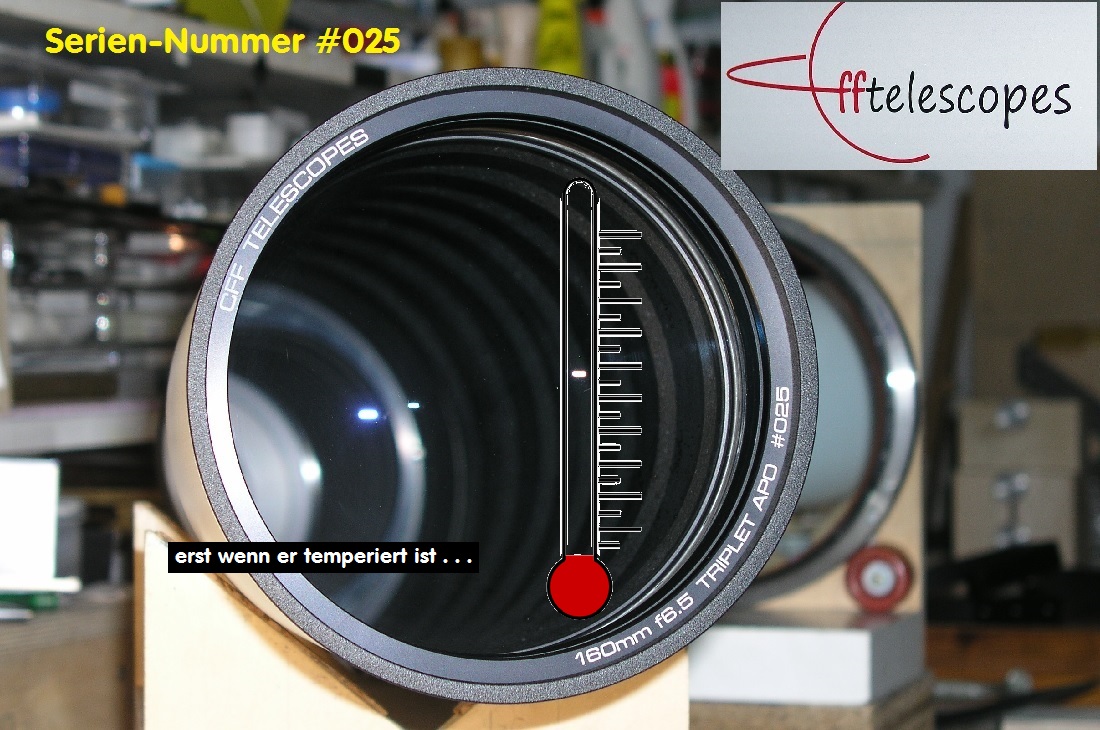
-
Im Objektiv-Block "arbeitete" es offenbar so heftig, daß man an dieser Gegenüberstellung den Effekt förmlich beobachten kann: Für die Praxis
heißt das aber, daß man das Teleskop senkrecht für mindestens 1 Stunde in Ruhe lassen sollte, damit sich die Optik der Außen-Temperatur
anpassen kann.

-
Es zogen also regelrechte Schwaden oder Schlieren durch das Foucault-Bild. Auch beim Interferogramm bewegten sich die Streifen im gleichen
Rhythmus, wie das Foucault-Bild. Man braucht deshalb ein wenig Geduld, wenn man die Spitzenleistung haben möchte.

-
Im Gegensatz zum A103B * CFF Telescopes Triplet APO 160/1050, serial #013, waren die Test-Ergebnisse bei diesem Teleskop Serial #025 so, wie
man sie eigentlich erwartet. Im Rauhheits-Test taucht zwar auch hier die Immersions-Flüssigkeit auf, anders als bei den üblichen Triplets mit Luft-
Linsen, die eine etwas glattere Oberfläche zeigen würden, verglichen mit dem Foucault-Bild (letztes Bild) ist dieser Effekt unauffällig.
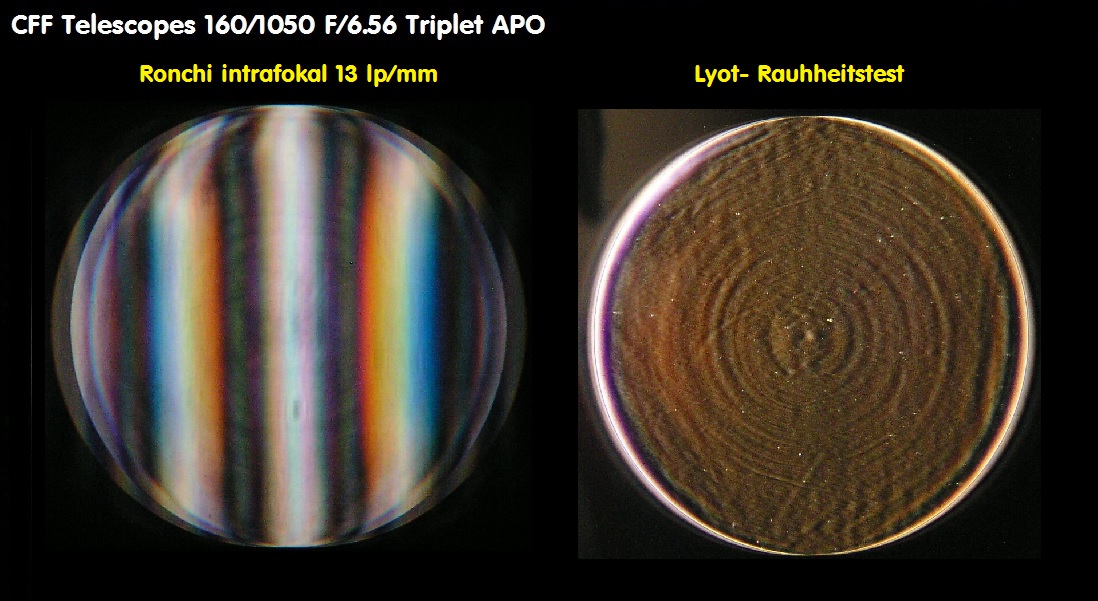
-
Sterntest und Artificial Sky Test zeigen bei hoher Vergrößerung eine gute Abbildung. Man darf nicht vergessen, daß man es mit einem lichtstarken
Triplet F6.56 zu tun hat. Die Immersion hat in diesem Fall eine höhere Transparenz.
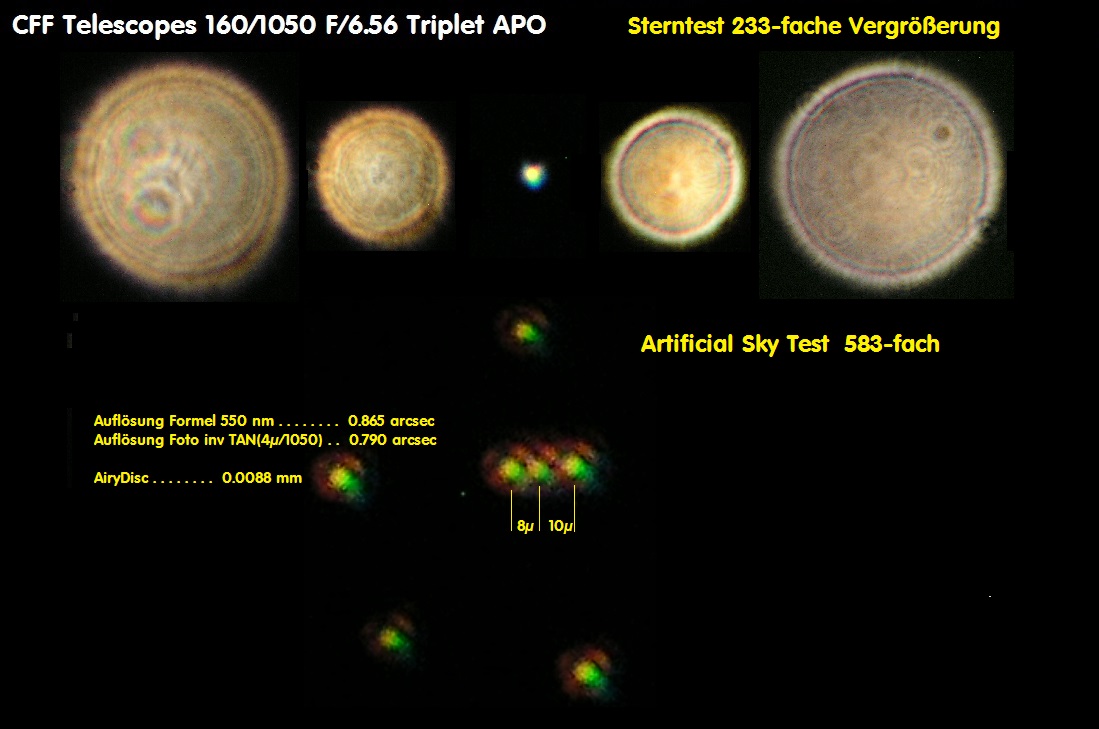
-
Auch das bei 532 nm wave entstandene Interferogramm läßt einen hohen Strehlwert erwarten.

-
Der Restfehler als Astigmatismus liegt bei geringfügigem PV L/8.6 und ist am Himmel nicht mehr wahrnehmbar. Rest-Koma wäre PV L/28.4
und Rest-Spherical PV L/18.9. Besser kann man es kaum herstellen.
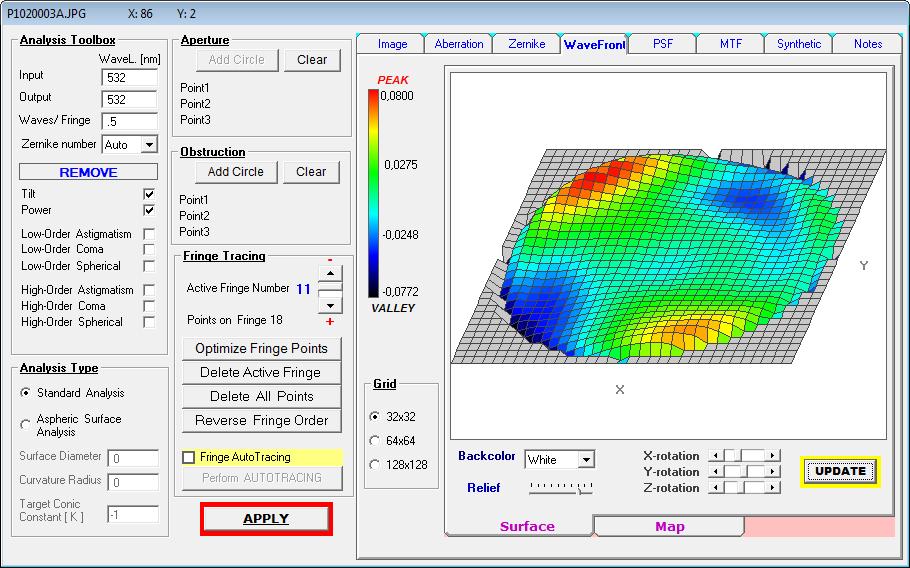
-
Die Energie-Verteilung entspricht dem Ideal, was bei einem Strehlwert von 0.971 nicht verwunderlich ist.
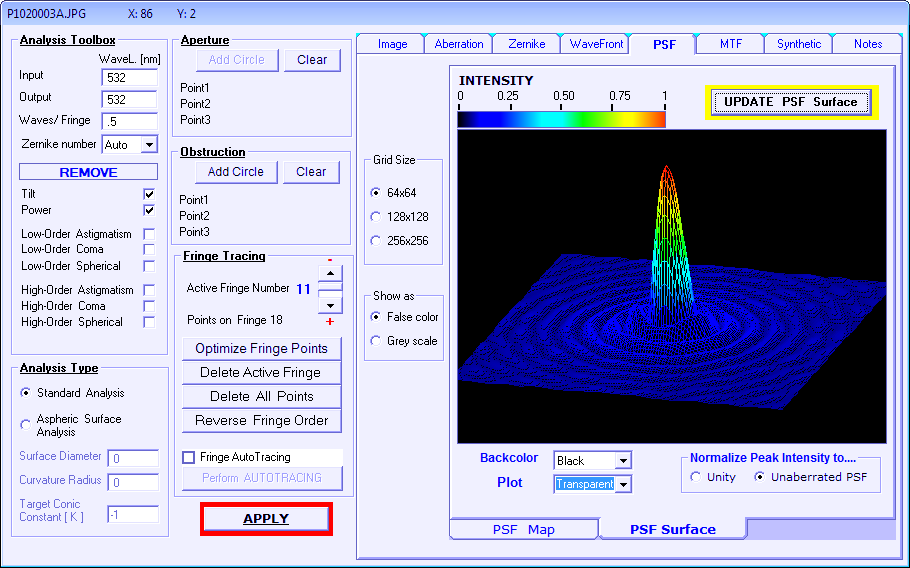
-
Die Auswertung auf Basis des oberen Interferogrammes.
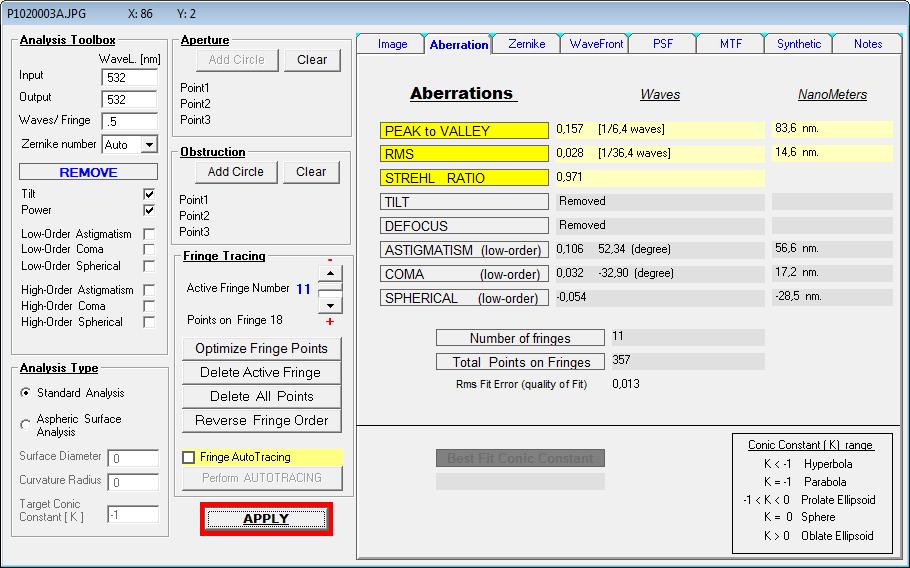
-
Und nun die Situation des Sekundären Spektrums. Für diesen Fall hätte ich aus Vergleichsgründen nochmals das "nachgebesserte" Teleskop
mit der Serien-Nummer #013 vermessen, weil sich beiden Teleskope zunächst unterscheiden, und ich die Unterschiede augenblicklich nicht
richtig zuordnen kann. Da ich die Serial #013 bereits vermessen hatte, würde mich interessieren, ob sich nach einem "Öl-Wechsel" am Sekundären
Spektrum etwas ändert. Den Gaußfehler zu Teleskop Serial #025 zeigt die untere Reihe im nächsten Bild: Das Optimum liegt lehrbuchhaft im
grünen Spektrum/e-Linie.
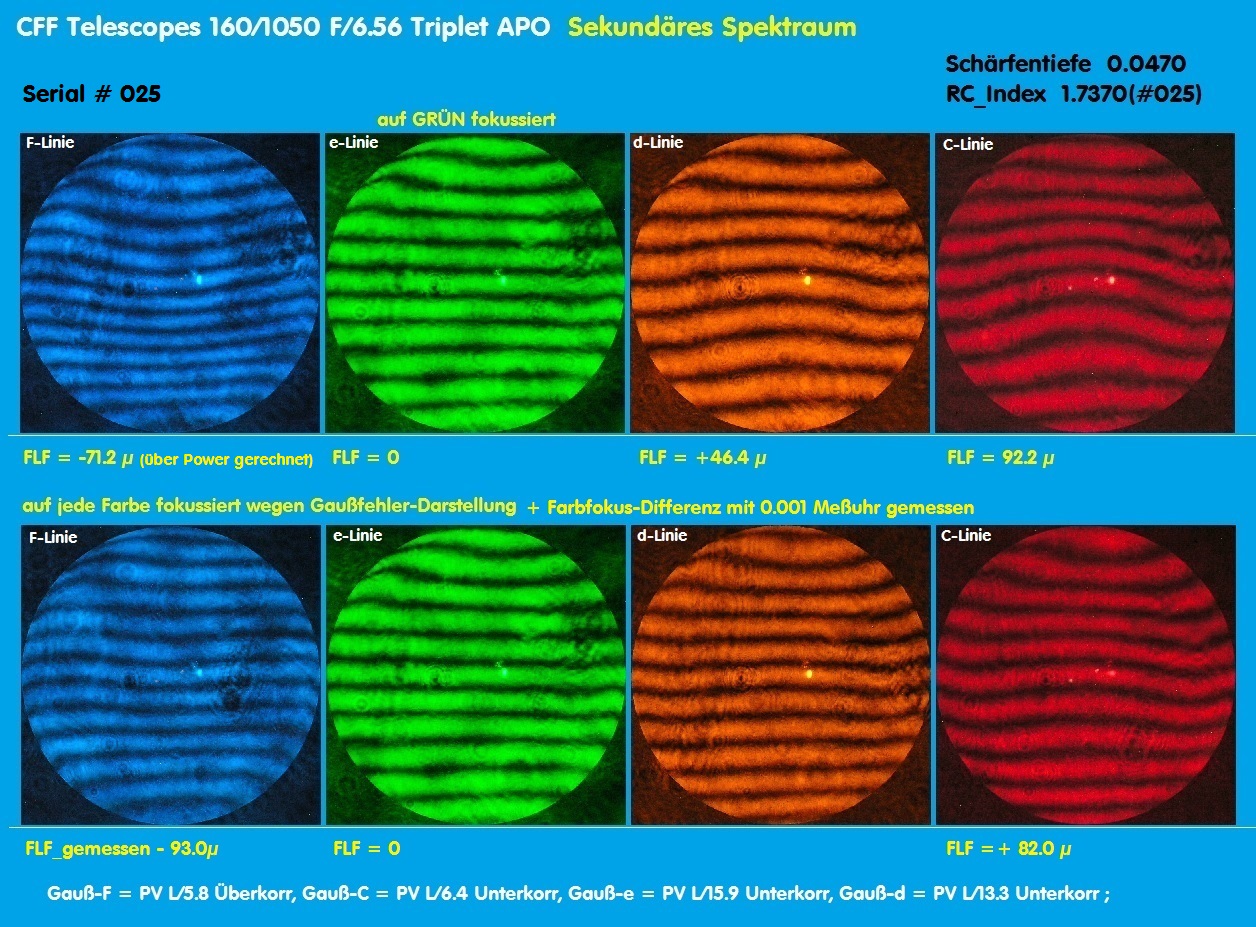
-
Für die Serical #025 wäre das die RC_Indexzahl über die Power gerechnet. Eine andere Möglichkeit besteht im Vermessen mit einer Digital-Meß-Uhr, was ich
zur Kontrolle ebenfalls überprüft habe: Hier wäre der Abstand von (F-e) /2 = 0.0875 und über die Formel kommt ein RC_Indexwert von 1.8616 heraus, was
immerhin die Berechnung über die POWER bestätigen würde, die eigentlich die "genauere" Methode ist.

In der Nacht verschiebt sich die spektrale Empfindlichkeit eines Durchschnitts-Auge von Grün nach Blaugrün: http://rohr.aiax.de/@Muster_Curve.png
Die Wahrnehmung von Rot verschwindet fast völlig. Damit steigert sich die "gefühlte" (empfundene) Farbreinheit eines Refraktors.
-
Deshalb ein Vergleich der Igramme der Serial # 025 oben und der Serial # 013 unten. Vielleicht läßt sich das in den nächsten Tagen klären.
Bei Serial #025 fällt auf, daß die blauen Streifen stärker nach oben kippen, ebenso die roten Streifen nach unten, wie bei Serial #013. Das
Optimum liegt bei GRÜN.
Bei Serial #013 fällt auf, daß sowohl bei Blau, als auch bei Rot die Streifen kaum nach oben, bzw. nach unten kippen. Nur der Gaußfehler wäre
wahrzunehmen, der deswegen verschieden sein muß, weil das Optimum an unterschiedlichen Stellen im Spektrum liegt. So ist bei diesem Teleskop
das Optimum zwischen Gelb und Rot, und man hat damit eine andere Situation, als beim Refraktor Serial #025. Die Suche nach einer Poly-Strehl-
Darstellung hätte auch hier die allergrößten Schwierigkeit, auch das Poly-Strehl-Diagramm aus dem Design würde kaum weiterhelfen.
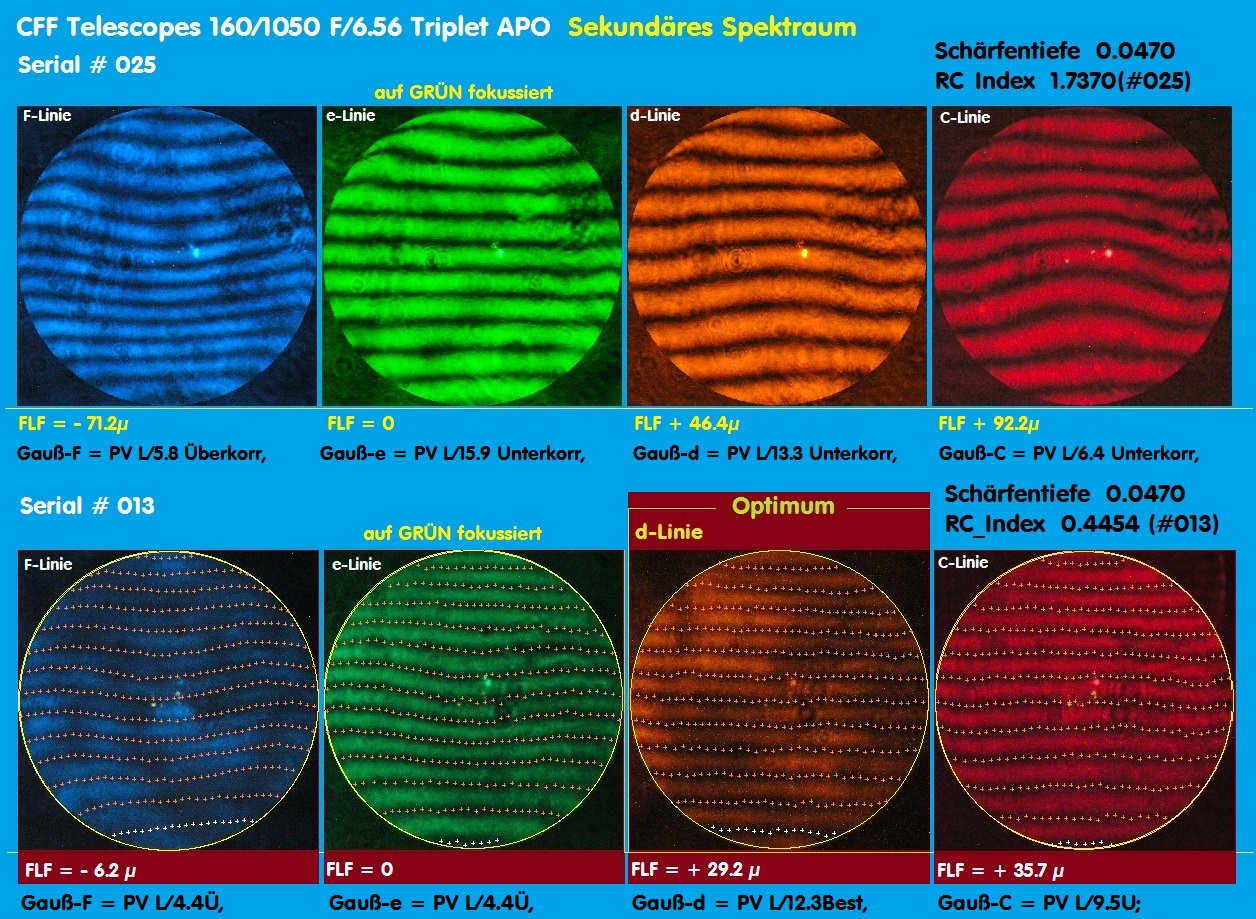
-
Auch ein Vergleich der beiden Foucault-Bilder, um die Unterschiede beim Sekundären Spektrum besser einschätzen zu können.

-
Im Vergleich schneidet der Artificial Sky Test beim neuen CFF Serial # 025 ebenfalls wesentlich besser ab. Da bei der Nachtbeobachtung der
Rot-Anteil bis auf ca. 10% "abgeschnitten" wird, entsteht auch im Labor eine bessere Abbildung, wenn man den Rot-Anteil abblendet.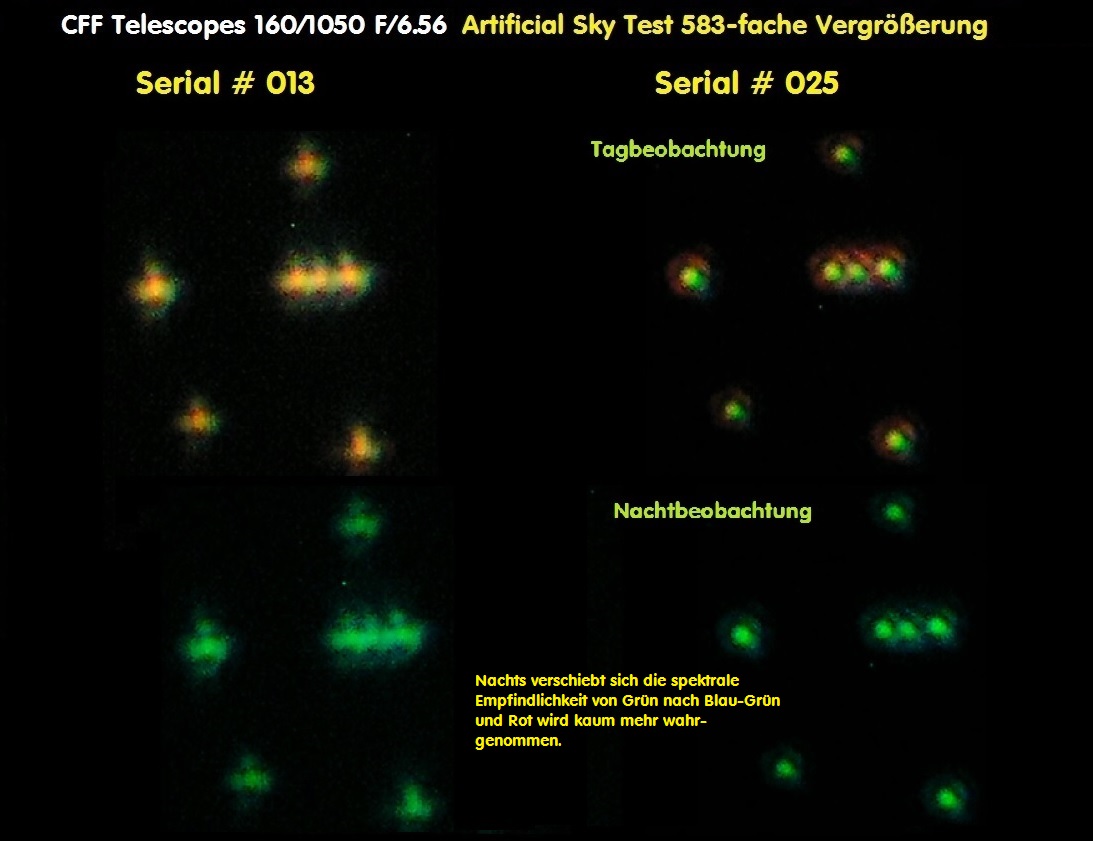
Kommentare
I am Pal Gyulai and all the APO lenses in CFF telescopes are designed and built by me. I aspherize, measure and adjust them by my own hands. No part of production is done in China.
ALL the lenses made by me have better than lambda/25 spherical correction in green color, at 532nm wavelength. When the no.13 lens arrived back, I measured it after 24 hours of waiting. Result was lambda/29,78. You measured a different value because the lens was colder than the room, when measured. This is natural. A few hours of thermailizing is not enough for these large lenses if you want to measure Strehl with high precision. A minimum wait time of 4-6 hours is recommended.
The no.13 lens has "visual" color correction, so, it performs optimally without glass in the light path. In the meantime we changed the default color correction to "photographic" because:
- with a, 1.25" prism diagonal these lenses perform absolutely optimally for planetary observation (but with a mirror they are still excellent, the difference in the eyepiece is small)
- without glass in the light path they are corrected for very wide wavelength-range, so, they can be used with CCD sensors (from 400nm to 1000nm) without false color in the photographs
- adding an 1.25" prism diagonal causes lambda/50 spherical overcorrection (at this focal ratio) which is mostly negligible, but on the other hand, it moves the spherical null towards red color, which is good for planets, as they have much more surface features in the red part of the spectrum (surface features of Mars, Jupiter, etc.)
We believe this lens design is optimal.
Pal Gyulai
nice to hear from you. My main interest for serial #013 ist the Secondary Spectrum. For serial #025
it's longer than for serial #013. And I hope to test this a second time, to controll my own testings.
Serial #025 I tested it twice: first the lens was to cold about 10°C and after 12 hours later it was
a perfect lens, as my report shows. But I don't know, how many hours this type of lens has to temper.
So I think, it was enough time for that.
Quote"The no.13 lens has "visual" color correction," No, perhaps photografic correction. Compare
this image: http://rohr.aiax.de/CFF_tel_12.jpg. Serial #025 could be visual corrected, but with a long
Secondar Spectrum. Nowhere I've found any information, that you designed these lenses with a
zenith prism. Normally I test this lens without any 50 mm prism or glas path.
So the lens serial #013 I hope to get it for a second test, and then I could confirm you or not.
Many regards from Wolfgang
thanks for your comments!
Regarding lens no. 25. the problem is NOT SECONDARY spectrum, but "TERTIARY" spectrum. In the case of secondary spectrum, both blue and red colors are de-focused in the same direction. So, both red and blue lines should "bend" in the same direction. Just like achromats do this.
In the image you kindly linked, the blue lines of lens no. 25 are bending "upwards", while the red lines are bending "downwards". Adding e.g. 30mm glass path would decrease the de-focusing of BOTH colors and 50mm glass would make an even stronger change in color correction. It only depends on taste of the observer.
The difference between secondary and tertiary spectrum is that tertiary spectrum can be easily decreased by adding some glass in the light path, so, with simple a prism you can decrease it significantly, or "null it out" totally. This is why we can happily leave tertiary spectrum in the lens INTENTIONALLY, in order to make the color correction range wider (400nm - 1000nm) for photography.
On the other hand, you can NOT decrease the amount of secondary spectrum with a prism, if you add glass and improve the lens in e.g. blue, then red color will become even worse and vice versa. So, secondary spectrum CAN NOT be left in the lens intentionally as it CAN NOT BE CORRECTED by simply adding a prism.
With lens no. 25 the difference in measured spherical correction was much smaller than it was for no. 13, because the second lens had much more time to warm up. 12 hours is perfect, so, there the difference was minimal (and could be caused by different measurement wavelength, I measure green at 532nm). But for the first lens you measured spherical null in orange color, while that lens was also perfect at 532nm. That lens obviously had less time to warm up (and that was in the colder winter).
Kind Regards,
Pal Gyulai
Normally the term "Secondary Spectrum" belongs to an achromatic lens http://rohr.aiax.de/ref-rutten03D.jpg and the term
"Tertiary Spectrum" belongs to apochromat: http://rohr.aiax.de/Apochromatic_focus_shift.jpg
Serial #025 shows at http://rohr.aiax.de/CFF_tel_10.jpg a tertiary spectrum and GREEN is Null. Then BLUE is shorter with -71.2 mircron
and RED is longer with + 92.2 micron. But this spectrum of #025 is much longer than the spectrum of #013, see here:
http://rohr.aiax.de/CFF_tel_12.jpg
I would calculate both this with the formula: http://rohr.aiax.de/RC_Index.png.
many regards and thank you for answering
Alle Kommentare dieses Beitrages als RSS-Feed.